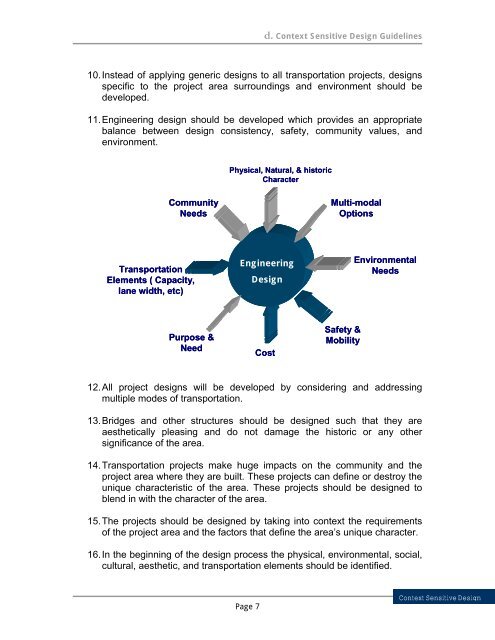Context Sensitive Design Guidelines - sacog
Context Sensitive Design Guidelines - sacog Context Sensitive Design Guidelines - sacog
d. Context Sensitive Design Guidelines 10. Instead of applying generic designs to all transportation projects, designs specific to the project area surroundings and environment should be developed. 11. Engineering design should be developed which provides an appropriate balance between design consistency, safety, community values, and environment. Physical, Natural, & historic Character Community Needs Multi-modal Options Transportation Elements ( Capacity, lane width, etc) Engineering Design Environmental Needs Purpose & Need Cost Safety & Mobility 12. All project designs will be developed by considering and addressing multiple modes of transportation. 13. Bridges and other structures should be designed such that they are aesthetically pleasing and do not damage the historic or any other significance of the area. 14. Transportation projects make huge impacts on the community and the project area where they are built. These projects can define or destroy the unique characteristic of the area. These projects should be designed to blend in with the character of the area. 15. The projects should be designed by taking into context the requirements of the project area and the factors that define the area’s unique character. 16. In the beginning of the design process the physical, environmental, social, cultural, aesthetic, and transportation elements should be identified. Page 7 Context Sensitive Design
d. Context Sensitive Design Guidelines 17. Designs should be developed while respecting community values. 18. Community should be involved in the process at the very start of the project. 19. Other agencies should be coordinated with at the start of the project. 20. The engineering design of the project should not be developed only on the basis of the key transportation elements (mobility, economics, level of service, design life, capacity, material of construction) but should also include key elements of the project area such as character of area (historic, park land, riverfront, residential, commercial), community needs, and environmental considerations. 21. All appropriate features of Context Sensitive Design i.e. purpose and need, environment, safety, and public participation should be included in final design. 22. All the key elements of the design process i.e. functional classification, Level of Service, vertical and horizontal alignments, type of material, design capacity, design speed, noise reduction, traffic medians, safety barriers, crosswalks, sidewalks, landscaping, traffic signals, Roadway lights, drainage, etc should be considered contextually. 23. The final design of the project should be such that it: a. Serves its function and setting. b. Is in accordance with the original plan of the project that was developed through community involvement. c. Is in accordance with the environmental documentation prepared for the project. d. Blends in with the existing environment and is aesthetically pleasing. e. Has minimum impacts to the existing environment. f. Is consistent with the surrounding land use and neighborhood requirements 24. All projects should include public participation. For Public participation, guidance should be obtained from Section 6 “Public Involvement” of this document. Page 8 Context Sensitive Design
- Page 1 and 2: Public Participation E d.nvironment
- Page 5 and 6: DDOT Context Sensitive Design Guide
- Page 7 and 8: d. Context Sensitive Design Guideli
- Page 9 and 10: DDOT Context Sensitive Design Guide
- Page 11 and 12: d. Context Sensitive Design Guideli
- Page 13 and 14: d. Context Sensitive Design Guideli
- Page 15: d. Context Sensitive Design Guideli
- Page 19 and 20: d. Context Sensitive Design Guideli
- Page 21 and 22: DDOT Context Sensitive Design Guide
- Page 23 and 24: DDOT Context Sensitive Design Guide
- Page 25 and 26: d. Context Sensitive Design Guideli
- Page 27 and 28: d. Context Sensitive Design Guideli
- Page 29 and 30: d. Context Sensitive Design Guideli
- Page 31 and 32: d. Context Sensitive Design Guideli
d. <strong>Context</strong> <strong>Sensitive</strong> <strong>Design</strong> <strong>Guidelines</strong><br />
10. Instead of applying generic designs to all transportation projects, designs<br />
specific to the project area surroundings and environment should be<br />
developed.<br />
11. Engineering design should be developed which provides an appropriate<br />
balance between design consistency, safety, community values, and<br />
environment.<br />
Physical, Natural, & historic<br />
Character<br />
Community<br />
Needs<br />
Multi-modal<br />
Options<br />
Transportation<br />
Elements ( Capacity,<br />
lane width, etc)<br />
Engineering<br />
<strong>Design</strong><br />
Environmental<br />
Needs<br />
Purpose &<br />
Need<br />
Cost<br />
Safety &<br />
Mobility<br />
12. All project designs will be developed by considering and addressing<br />
multiple modes of transportation.<br />
13. Bridges and other structures should be designed such that they are<br />
aesthetically pleasing and do not damage the historic or any other<br />
significance of the area.<br />
14. Transportation projects make huge impacts on the community and the<br />
project area where they are built. These projects can define or destroy the<br />
unique characteristic of the area. These projects should be designed to<br />
blend in with the character of the area.<br />
15. The projects should be designed by taking into context the requirements<br />
of the project area and the factors that define the area’s unique character.<br />
16. In the beginning of the design process the physical, environmental, social,<br />
cultural, aesthetic, and transportation elements should be identified.<br />
Page 7<br />
<strong>Context</strong> <strong>Sensitive</strong> <strong>Design</strong>



